Table of Content:-
- Evolution of Victorian Era Fashion
- Women’s Fashion in Victorian Era
- Men’s Fashion in Victorian Era
- Children’s Fashion in Victorian Era
- Fashion Icons and Influencers in that Era
- Legacy of Victorian Fashion
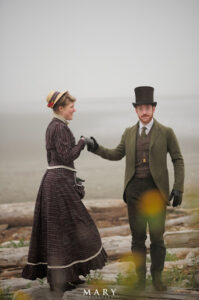
Victorian-era-fashion
Evolution of Victorian Era Fashion
Early Victorian Fashion
In the early Victorian era, women’s fashion featured full skirts supported by layers of petticoats. Corsets were tight, shaping the waist into an hourglass figure. Sleeves were often wide and puffed, and bonnets were popular accessories. Men’s fashion included tailcoats, waistcoats, and cravats. The clothing was formal and highlight humbleness, reflecting the era’s cultural values.
Mid-Victorian Fashion
The crinoline, a hoop skirt made of steel, became fashionable, allowing skirts to be even fuller without heavy petticoats. Women’s dresses had narrower waists and wider skirts. Men’s suits became more fitted, with frock coats and bowler hats gaining popularity. Clothing became more accessible due to the Industrial Revolution, which introduced mass production techniques.
Late Victorian Fashion
It replaced crinolines, creating a pronounced back silhouette. Women’s skirts became slimmer in the front and fuller at the back. High-necked blouses and tailored jackets became fashionable. Men’s fashion saw the rise of the three-piece suit, with sack suits and bow ties becoming common. This period also saw the influence of aesthetic and artistic movements, which encouraged more and decorative styles.
End of Victorian Fashion
The “Gibson Girl” look, featuring a tall, slim silhouette with an S-shaped curve, became iconic. Men’s fashion remained relatively unchanged, with the lounge suit becoming a staple. Ready-to-wear clothing became more common, making fashion more accessible to the middle class. By the end of the Victorian era, fashion was beginning to move towards the simpler styles of the Edwardian era.
Women’s Fashion in Victorian Era
Early Victorian Women’s Fashion
Women’s dresses in the early Victorian era had full skirts supported by multiple layers of petticoats. Tight corsets were worn to create an attractive shape, with making a narrow waist. Sleeves were often large and puffed, and bonnets were common accessories. Fabrics were typically heavy and modest, reflecting the traditional values of the time. Dresses were usually made of cotton or silk, and dark colors were popular.
Mid-Victorian Women’s Fashion
The crinoline, a cage-like structure made of steel, became popular, allowing skirts to be wider and fuller without the weight of many petticoats. Bodices were tight-fitting, and skirts had a dome shape. Corsets remained essential for shaping the waist. Day dresses had high necklines and long sleeves, while evening gowns featured lower necklines and short sleeves. Rich fabrics and makes trims like lace and ribbons were fashionable.
Late Victorian Women’s Fashion
Bustles replaced crinolines, creating a pronounced shape at the back of skirts. This style made the front of the dress appear slimmer. High-necked blouses and tailored jackets became fashionable, and skirts started to narrow. Corsets were still worn but now highlight the more natural waistline. Fabrics were luxurious, and detailed decorations like embroidery and beadwork were popular. The use of patterns and bright colors increased, reflecting the influence of artistic movements.
End of Victorian Women’s Fashion
The “Gibson Girl” look, featuring a tall, slim figure with an S-shaped curve, became iconic. Blouses with puffed sleeves and skirts that flared at the bottom were common. Corsets were still used but were less restrictive. Daywear became simpler and more functional, while evening gowns remained elaborate. Ready-to-wear clothing became more available, making fashionable dresses accessible to more women.
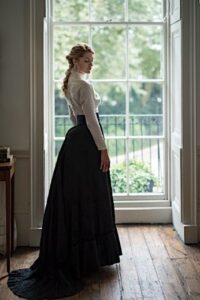
Victorian-era-fashion-Women
Men’s Fashion in Victorian Era
Early Victorian Men’s Fashion
Men’s fashion in the early Victorian era was formal and rare. Tailcoats, which had long tails at the back, were commonly worn with waistcoats and high-collared shirts. Cravats, which are wide neckties, were popular accessories. Trousers were high-waisted and often striped. Men also wore top hats to complete their look. This style reflected the traditional and modest values of the time, maintain a polished and refined appearance.
Mid-Victorian Men’s Fashion
As the Industrial Revolution progressed, men’s fashion became more practical and fitted. Frock coats, which were knee-length and buttoned up the front, became popular for daytime wear. Waistcoats remained a key part of the outfit, often in contrasting colors. Trousers became looser and more comfortable. Bowler hats, which were sturdy and practical, replaced top hats for everyday use. This period saw clothing becoming more accessible due to mass production techniques.
Late Victorian Men’s Fashion
During this time, the three-piece suit became the standard for men’s fashion. It included a matching jacket, waistcoat, and trousers. Sack suits, which were looser and less structured, became fashionable for casual wear. Bow ties and neckties were both common, and hats like the bowler were popular. Men’s clothing started to incorporate more patterns and textures, reflecting a shift towards more diverse and personalized styles.
End of Victorian Men’s Fashion
By the end of the Victorian era, men’s fashion had become more relaxed and practical. The lounge suit, which was less formal than earlier styles, became widely accepted for everyday wear. This suit featured a single-breasted jacket, often worn with a matching waistcoat and trousers. Neckties became narrower and more standardized. Hats like the homburg and boater gained popularity. This period marked the transition towards the simpler and more comfortable styles that would characterize the Edwardian era.
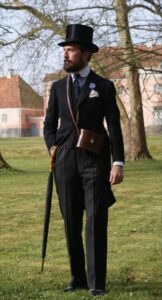
victorian-era-fashion-men
Children’s Fashion in Victorian Era
Early Victorian Children’s Fashion
In the early Victorian era, children’s fashion closely resembled adult clothing. Young boys wore dresses until about the age of five, after which they transitioned to breeches and tunics. Girls wore long dresses with petticoats and bonnets, much like their mothers. The clothing was often maintained and restrictive, reflecting the formality of the time. Boys’ outfits often included sailor suits, while girls’ dresses featured lace and ribbons.
Mid-Victorian Children’s Fashion
During the mid-Victorian period, children’s clothing began to include more practical and comfortable elements. Boys started wearing knickerbockers, knee-length pants, with blouses and jackets. Girls’ dresses became slightly shorter, allowing more freedom of movement. Sailor suits remained popular for boys, symbolizing the British naval pride. Children’s clothing started to reflect a balance between practicality and the prevailing fashion trends of the time.
Late Victorian Children’s Fashion
As the Victorian era progressed, children’s fashion became more distinct from adult clothing. Boys wore knickerbocker suits with knee-length trousers and matching jackets, often paired with Eton collars and caps. Girls’ dresses featured high necklines, puffed sleeves, and flared skirts, often decorated with lace and bows. This period also saw the introduction of ready-made children’s clothing, making fashionable outfits more accessible to a wider range of families.
End of Victorian Children’s Fashion
By the end of the Victorian era, children’s fashion had become more relaxed and child-friendly. Boys commonly wore short trousers with shirts and jackets, and sailor suits remained a popular choice. Girls’ dresses were more practical, with simpler designs that allowed for ease of movement. Both boys and girls wore comfortable, loose-fitting play clothes for daily activities. This period marked a shift towards recognizing the need for children’s clothing to be both practical and stylish and comfortable styles of the Edwardian era.
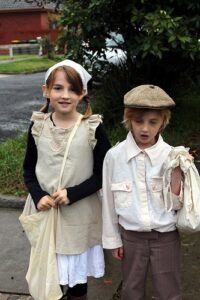
victorian-Era-fashion-childrens
Fashion Icons and Influencers in that Era
Queen Victoria
Queen Victoria was the most significant fashion icon of the Victorian era. Her influence was profound, and her style choices set trends throughout her reign from 1837 to 1901. When she married Prince Albert, her white wedding dress became incredibly popular, making white the standard color for bridal gowns. Her preference for modest and rare clothing, including high-necked dresses and long skirts, influenced the era’s fashion norms. Victoria’s mourning attire after Prince Albert’s death also popularized black as a color of mourning, which was widely adopted in society.
Charles Frederick Worth
Charles Frederick Worth, an English fashion designer based in Paris, was a leading influencer in Victorian fashion. Often called the “father of haute couture,” Worth revolutionized fashion by creating the concept of designer labels. He introduced the idea of fashion houses and seasonal collections, allowing clients to see designs and choose fabrics before the garments were made. Worth’s maintains and luxurious designs, including the crinoline and bustle, were highly sought after by the wealthy elite, setting high standards in fashion and inspiring other designers.
Empress Eugénie of France
Empress Eugénie, the wife of Napoleon III, was a major fashion influencer in the Victorian era. Known for her rare and beauty, she was a trendsetter whose style was widely admired and emulated. She favored the designs of Charles Frederick Worth, and her patronage helped establish his reputation. Empress Eugénie’s fashion choices, such as luxuary ball gowns, luxurious fabrics, and highlight accessories, influenced both French and British high society. Her perfect taste and royal status made her an enduring icon of Victorian fashion, shaping the era’s aesthetics.
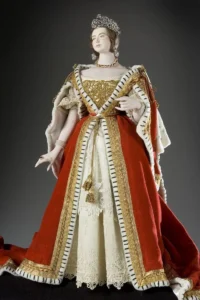
victorian-era-fashion-queen-dress
Legacy of Victorian Fashion
Revival of Vintage Fashion Trends
Victorian fashion periodically experiences revivals, with designers drawing inspiration from its complex designs and romantic silhouettes. Vintage-inspired clothing, featuring elements like ruffles, lace, and high collars, remains popular among fashion addict, contributing to the enduring legacy of Victorian style.
Influence on Costume Design
Victorian fashion heavily influences costume design in film, theater, and themed events. The era’s distinctive clothing styles are often recreated to evoke specific historical periods or to convey character traits, adding verity and visual interest to productions.
Preservation in Fashion Museums and Exhibitions
Many fashion museums and exhibitions showcase Victorian garments, preserving their legacy and educating visitors about the era’s fashion trends and societal norms. These displays highlight the craftsmanship and artistry of Victorian clothing, ensuring that its influence is appreciated by future generations.
source by:- https://images.app.goo.gl/xJcAftXRL4mHRu476 , https://images.app.goo.gl/ex5eFJCS7A4LCrvM9
https://images.app.goo.gl/9FTVp3Auj3k2pTbaA , https://images.app.goo.gl/Yq4oiTrarfkZ6y386 , https://images.app.goo.gl/73bxzoHm8A2AqPx58
written by:- https://bioleather.in/
